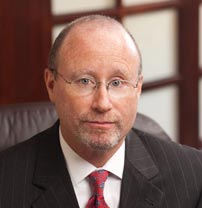November 19, 2014

By Harold B. Yellin
Special to Business in Savannah
HunterMaclean held its annual speaker series, the Critical Issues Forum, on October 8 at Savannah Technical College. The Firm has presented the Critical Issues Forum in Savannah each year since 2004 and in Brunswick since 2012, bringing together leaders from industry, government, education, and non-profit organizations for a breakfast gathering to hear speakers on important issues. This year, HunterMaclean partnered with the Savannah Area Chamber of Commerce and the Savannah Economic Development Authority (SEDA) for a forum titled Building the Best Downtowns in America: A Conversation with Mayor Knox White.
Over the past 40 years, Greenville, S.C., has reinvented itself from a textile manufacturing economy to a highly diversified and advanced manufacturing hub. Its downtown, which had fallen on hard times, is now active with street life, restaurants, retail, and residential communities.
Greenville Mayor Knox White has led the city through 18 years of that remarkable transformation with the goal of making Greenville “the most beautiful and livable city in America.” In his fascinating and inspiring keynote presentation, Mayor White laid out how Greenville turned around its economy and carefully developed a vibrant and prosperous downtown.
As Savannah works through major decisions on projects that will impact downtown for decades to come, here are my takeaways on what we can learn from Greenville’s success:
Planning and partnerships
Mayor White emphasized that much of Greenville’s development is a product of partnerships between the private and public sectors. Of course there are stringent requirements to be met, but within those parameters the city has encouraged a mixed-use environment and launched major redevelopment projects that have attracted substantial private investment.
Cracking the code of urban planning: mixed use
Every project that Greenville undertakes is mixed use—in Mayor White’s words, “with a real intent.” By combining office, retail, and residential downtown, the streets have foot traffic around the clock. Hotels have offices and retail. Parking garages are blended with housing. Office buildings have retail space. Even Greenville’s downtown baseball stadium is mixed use, with restaurants, retail, apartments, and condos, ensuring that the facility—and the area surrounding it—is never dead space.
Invest to grow
The iconic Greenville story is how the city reclaimed a downtown river and a waterfall that had been covered up by a state highway. Over a period of many years and with work by many civic groups, the city invested $13 million to create Falls Park, an urban oasis in a previously undeveloped section of Main Street. Although there were many detractors, the park has become one of the anchors of downtown Greenville, sparking $150 million in private development nearby.
Greenville has also had great success with Tax Increment Financing (TIF), which uses taxes on a given area to support city expenditures there such as parking garages, infrastructure, and, in Greenville’s case, additional policing. Savannah has tried TIF in the past, but Greenville’s successful example may warrant reconsideration.
The goal of the Critical Issues Forum is to be a catalyst, to bring forward new ideas and to initiate dialogue in our community. My hope is that everyone who attended left with something to think about as we continue our quest to call Savannah the best downtown in America.
The full program may be viewed at this link: https://vimeo.com/110926417




